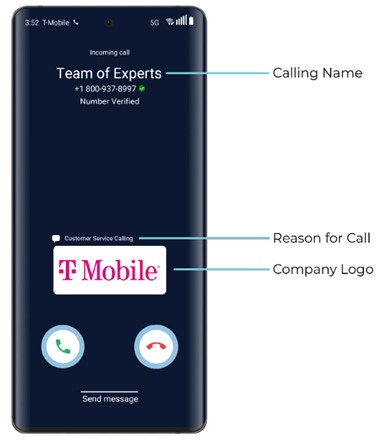Get ready for the era of 'branded calls'
Branded calls could allow businesses to insert things like their name, the reason for their call, and even potentially their corporate logo into a smartphone's calling screen.

It appears the wireless industry in the US is gearing up to support "branded calls." Such calls will allow businesses to insert things like their name, the reason for their call, and even potentially their corporate logo into a smartphone's calling screen.
According to the companies promoting the technology, branded calls can help reduce the nuisance of spam calls, and can create more trust in the nation's overall calling system. However, the technology may also allow voice calling providers to make more money by charging businesses to access this kind of Rich Call Data (RCD).
"Branded communication gives you complete control of your business name, identity and reason for call," touts branded calling vendor First Orion. "Branded communication is for businesses of all sizes. Our client portfolio includes call and contact centers, major retailers, financial institutions, automakers, concierge services and much more."
The company lists insurance provider Assurance and healthcare company Galileo among its customers. In the case of Galileo, First Orion boasted a 34 percent increase in Galileo's engagement with its customers via branded calls. "Customers were more likely to engage with phone calls because they recognized the business name," according to First Orion.
From robocalls to branded calling
Branded calling is an offshoot of the RCD standard developed by the ATIS trade group roughly two years ago. RCD leverages the STIR/SHAKEN framework promoted by the FCC as a way to tamp down on unwanted robocalls.
Now, the US wireless industry's main trade association, CTIA, recently told the FCC that it's "developing an RCD-based service called Branded Calling ID (BCID), which will utilize ATIS' RCD standard for purposes of branded calling." Already the association has released a "best practices" document that recommends, among other things, that companies using the branded calling system "validate the Caller Display Name, Call Logo, and Call Reason that a Caller wishes to use by demonstrating that the submitted Caller Display Name, Call Logo, and Call Reason are actually associated with the Caller."
Along those lines, calling technology vendors First Orion, Hiya, Neustar and Transaction Network Services (TNS) have already teamed up to create a unified way to vet the businesses using such calling service.
"Many service providers don't have the ability to confidently vet their customers or confirm the caller's true identity at scale," said Kush Parikh, president at Hiya, in a release. "Branded calls allow subscribers to make informed decisions about which calls to answer – and as result grow trust in the voice network."
And T-Mobile, at least, is interested. Last year the company said it had tested branded calling with the CTIA. "Those called by a business using BCI [branded caller ID] could even see the reason for the call, such as billing issues or delivery scheduling," T-Mobile argued. "Consumers can then make informed choices about whether to answer calls – staying safer from spam and scammers while not missing calls they want."
Verizon has also mentioned branded calling in some of its filings with the FCC, arguing that the agency should avoid putting rules and guidelines around the technology until it can mature.
The bigger picture
Wireless network operators like Verizon and T-Mobile have found little reason to innovate on established services like calling and texting. That's because virtually all of the industry's service plans offer unlimited access to calling and texting. Meaning operators generally can't squeeze out more revenues from their customers for calling and texting improvements.
Further, such improvements are often contingent on support from smartphone makers like Samsung and Apple. In some cases – such as Rich Communications Services (RCS) for text messages – that support isn't uniform.
As noted by First Orion, branded calling is generally supported across both Android and iOS.
But branded calling is noteworthy because it would allow telecom companies to generate profits from the businesses placing calls rather than the end users answering them.
The prospect of getting more business revenues is clearly interesting to the global wireless industry. Already many in the sector are trying to sell private wireless networks to businesses of all shapes and sizes.
And that may just be the start. For example, the GSMA trade association has started pushing its new "Open Gateway" effort. The program seeks to create uniform Application Programmable Interfaces (APIs) into wireless networks globally. The hope is that enterprises will pay to access those APIs.
Related posts:
— Mike Dano, Editorial Director, 5G & Mobile Strategies, Light Reading | @mikeddano
About the Author(s)
You May Also Like












